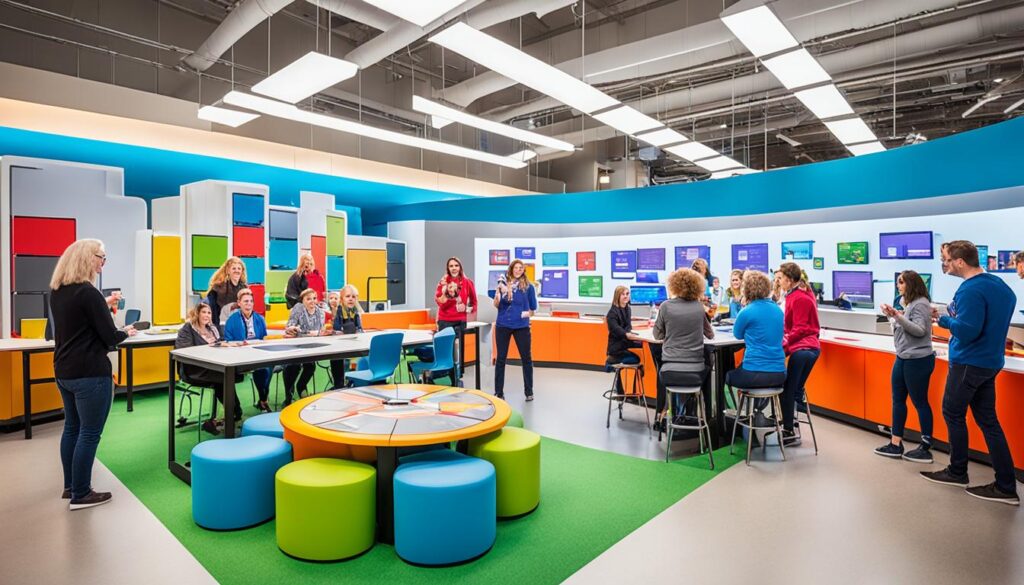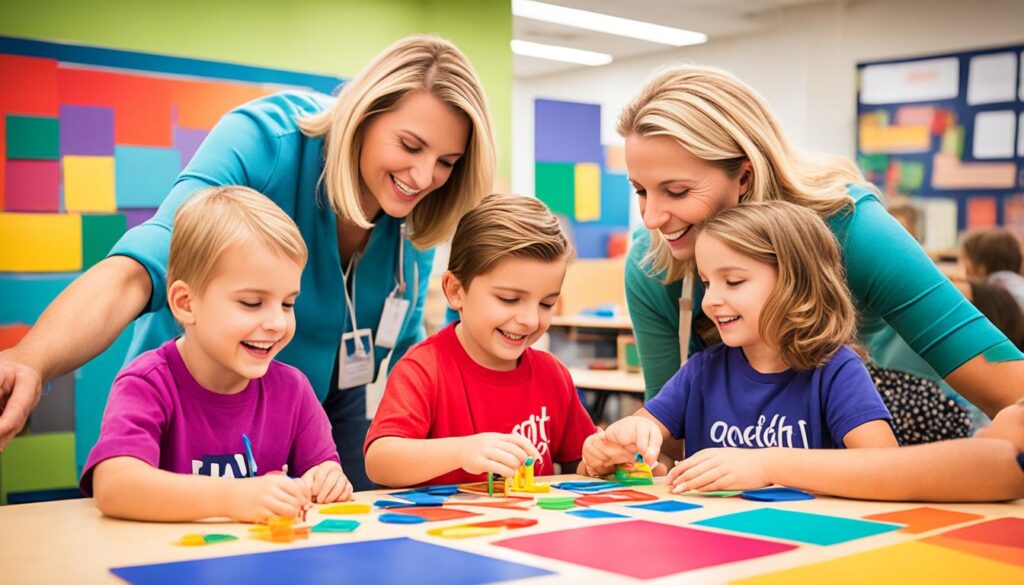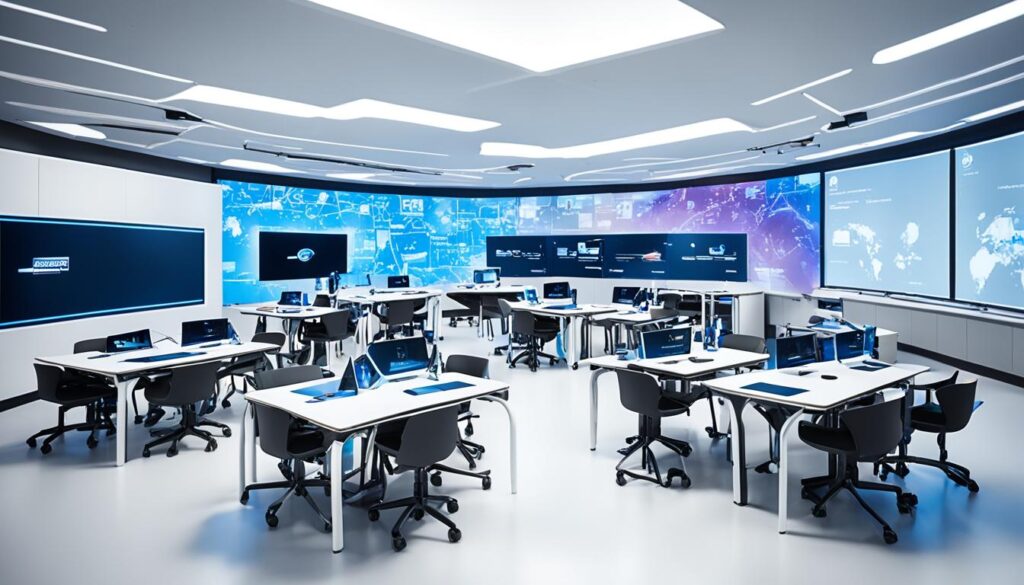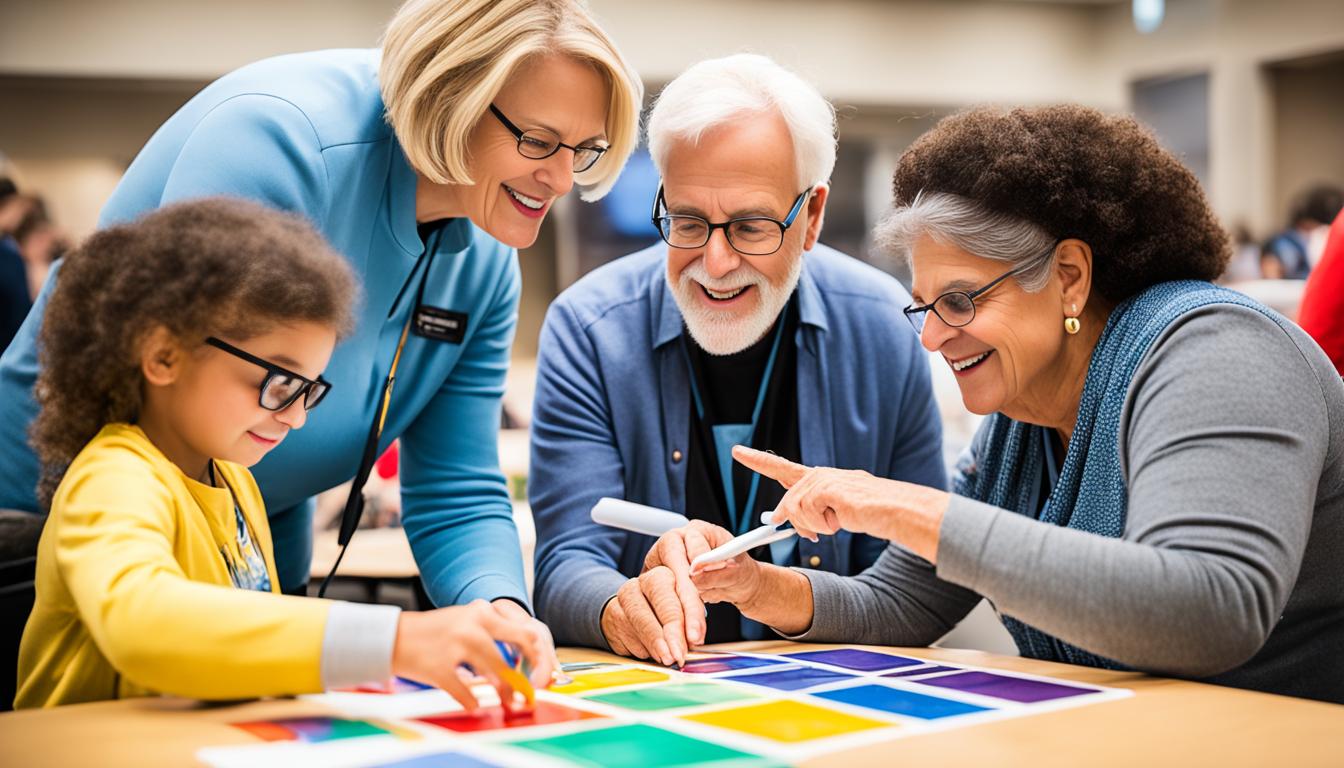Creative education programs have the power to unlock the potential of individuals of all ages. These programs aim to foster innovative learning, providing unique educational experiences that go beyond traditional teaching methods. From hands-on learning opportunities to interdisciplinary teaching approaches, creative education programs are revolutionising the way we educate and equip individuals with future-focused skills.
This article will explore the importance of creativity in modern education and delve into various aspects of innovative creative education programs for individuals of all ages.
Key Takeaways:
- Creative education programs foster innovative learning and provide unique educational experiences beyond traditional teaching methods.
- Hands-on learning and interdisciplinary teaching approaches are key components of creative education programs.
- Artistic enrichment, interactive educational experiences, and imaginative teaching methods are integral to creative education programs.
- Creative education programs cater to individuals of all ages and equip them with future-focused skills.
- Innovative creative education programs have the potential to transform individuals and society as a whole.
The Importance of Creativity in Modern Education
In today’s rapidly changing world, creativity plays a crucial role in education. It fosters innovation, critical thinking, and problem-solving skills among learners, equipping them with the tools they need to navigate the complexities of the future.
Defining Creative Education
Creative education embraces an imaginative approach to teaching and learning. It goes beyond traditional methods, encouraging students to explore, experiment, and think outside the box. This approach nurtures individuality, allowing learners to express themselves, discover their passions, and develop a deep sense of self-confidence.
The Benefits of an Imaginative Curriculum
An imaginative curriculum provides students with a dynamic learning experience. It invites them to be active participants in their education, sparking curiosity and a lifelong love of learning. By engaging with diverse and challenging content, students develop their creativity, critical thinking, and problem-solving skills, preparing them for success in a rapidly evolving world.
Adapting to Diverse Learning Styles Through Creative Education Programs
Every learner is unique, with their own preferred learning style. Creative education programs recognize and embrace this diversity, providing opportunities for students to engage with content in ways that resonate with them. Whether through visual, auditory, or kinesthetic methods, these programs ensure that every student can thrive and reach their full potential.
The innovative teaching methods employed in creative education programs cater to different learning styles, making education accessible and meaningful for all students. By tailoring instruction to meet individual needs, these programs create inclusive and supportive learning environments that celebrate the unique strengths of every learner.
Creativity is not a luxury in education; it is the driving force behind transformative learning experiences. By embracing creativity in education, we empower students to think critically, adapt to change, and contribute to a better future.
Revolutionising Learning: Interactive Educational Experiences
In today’s rapidly evolving educational landscape, interactive educational experiences have emerged as a powerful tool for revolutionising learning. These experiences are at the forefront of creative education programs, providing students with engaging learning environments that foster active participation and collaboration.
Employing Technology for Engaging Learning Environments
Technology plays a crucial role in creating these engaging learning environments. By harnessing the power of technology, educators can introduce interactive elements that enhance student engagement and promote a deeper understanding of concepts. From gamification to virtual reality, technology offers a wide range of tools and platforms that make learning more interactive, immersive, and meaningful.
One example of technology in learning is the use of gamification, where elements of games are incorporated into educational activities. This approach motivates students through rewards, challenges, and competition, making the learning process more enjoyable and interactive. Gamification not only enhances student participation but also fosters critical thinking, problem-solving skills, and teamwork.
Virtual reality (VR) is another technology that is transforming learning experiences. By immersing students in virtual environments, VR allows them to explore and interact with concepts that might be otherwise inaccessible. From virtual field trips to historical simulations, VR provides students with immersive learning experiences that enhance their understanding and retention of information.

Interactive Methods to Enhance Student Participation
In addition to technology, various interactive methods can be employed to enhance student participation and engagement. These methods encourage active learning, critical thinking, and problem-solving skills.
- Collaborative Projects: Encouraging students to work together on projects fosters collaboration, communication, and teamwork. By engaging in collaborative projects, students learn from each other’s perspectives, brainstorm creative solutions, and develop essential interpersonal skills.
- Discussion-Based Learning: Facilitating discussions and debates in the classroom promotes critical thinking and deepens students’ understanding of complex topics. By actively participating in discussions, students develop their ability to express their ideas, analyze different viewpoints, and articulate logical arguments.
- Hands-On Experiments: Hands-on experiments and practical activities provide students with opportunities to apply their knowledge in real-world contexts. Through hands-on learning, students develop problem-solving skills, scientific inquiry abilities, and a deeper understanding of theoretical concepts.
Case Studies: The Success Stories of Interactive Learning
Real-life case studies serve as powerful evidence of the effectiveness of interactive learning methods in educational settings. They showcase the impact of immersive learning methods and provide insights into best practices for implementing interactive educational experiences.
| Case Study | Program Description | Outcomes |
|---|---|---|
| STEM Robotics Program | A robotics program that combines hands-on building, coding, and problem-solving challenges. | Increased student engagement, improved understanding of STEM concepts, and development of critical thinking skills. |
| Virtual Museum Tour | A virtual reality experience that allows students to explore museums and historical sites from the comfort of their classrooms. | Enhanced cultural understanding, expanded access to educational resources, and increased motivation to learn. |
| Online Simulations | Simulation-based learning modules that provide students with experiential learning opportunities in various subjects. | Improved problem-solving skills, increased student engagement, and deeper conceptual understanding. |
These case studies demonstrate how interactive educational experiences can transform learning outcomes, motivate students, and create a more engaging and effective educational ecosystem.
Pioneering Interdisciplinary Teaching Approaches
Interdisciplinary teaching approaches are revolutionizing creative education programs by providing a holistic education that goes beyond the boundaries of traditional subject silos. By integrating different subjects, educators create a more interconnected and meaningful learning experience for students, fostering critical thinking and problem-solving skills.
One innovative teaching approach employed in interdisciplinary education is project-based learning, where students work collaboratively on real-world projects that require the integration of knowledge from multiple disciplines. This approach not only enhances students’ understanding of subject matter, but also develops their ability to make connections across different areas of study.
Another approach is the use of experiential learning, where students engage in hands-on activities and real-world experiences. For example, a science project on renewable energy could incorporate elements of mathematics, physics, and environmental studies, providing students with a comprehensive understanding of the topic.
Interdisciplinary teaching also nurtures students’ creativity and fosters a broader perspective on complex issues. By exploring topics from different angles and considering multiple viewpoints, students develop critical thinking skills and the ability to approach problems from various perspectives.
Fostering Artistic Enrichment Across Age Groups
The arts play a crucial role in creative education programs, contributing to artistic enrichment and nurturing creativity in individuals of all ages. Incorporating arts into STEM education is a compelling way to foster interdisciplinary learning and promote a well-rounded education. By integrating arts into the curriculum, educators can create a STEAM (Science, Technology, Engineering, Arts, and Mathematics) approach that encourages students to explore the synergies between different disciplines and develop a more holistic understanding of the world.
Community art projects further promote artistic endeavors by providing opportunities for collaboration and engagement. These projects bring individuals together to create meaningful artworks that reflect the rich diversity and cultural heritage of their communities. Such initiatives not only foster artistic expression but also contribute to community building, social cohesion, and a sense of belonging.
Artistic enrichment goes beyond the development of aesthetic skills; it also enhances cognitive development. Engaging in artistic activities nurtures essential skills such as problem-solving, critical thinking, and communication. Through the exploration of various artistic mediums, individuals develop their imaginations, learn to express themselves, and cultivate their own unique creative voices. Artistic enrichment also encourages individuals to think outside the box, fostering a mindset of innovation and adaptability.
| Benefits of Artistic Enrichment |
|---|
| Enhances cognitive development |
| Promotes interdisciplinary learning |
| Fosters problem-solving and critical thinking skills |
| Encourages self-expression and creativity |
| Nurtures innovation and adaptability |
Embracing Hands-On Learning: Experiential Education
Experiential education is a cornerstone of creative education programs, providing learners with hands-on learning opportunities and real-world application of knowledge. This approach emphasizes the importance of practical learning, allowing learners to engage actively in their education and develop practical skills that are applicable in real-life situations.
At its core, experiential education involves immersing learners in authentic learning experiences that go beyond traditional classroom methods. Through internships, project-based learning, and simulations, learners are able to apply their knowledge in real-world contexts, gaining a deeper understanding of the subject matter. By actively engaging with the material in practical ways, learners develop critical thinking skills and problem-solving abilities that can be transferred to various situations they may encounter in their personal and professional lives.

The transformative impact of experiential education on learners’ personal and professional development is well-documented. By actively participating in hands-on learning experiences, learners not only acquire knowledge but also develop valuable skills such as teamwork, communication, and adaptability. These skills are essential in today’s rapidly changing world, where the ability to apply knowledge in real-world situations is highly valued.
Experiential education also fosters a deeper sense of connection and relevance to the subject matter. By immersing learners in real-world scenarios, they gain a clearer understanding of how the concepts they are learning can be applied in practical contexts. This not only enhances their understanding but also fosters a sense of enthusiasm and motivation for continued learning.
Overall, experiential education provides learners with the opportunity to bridge the gap between theory and practice, preparing them for success in the real world. By embracing hands-on learning and promoting real-world application of knowledge, creative education programs are equipping learners with the skills and experiences they need to thrive in an ever-evolving society.
Building Skills for the Future: Innovative Learning Initiatives
Building skills for the future is a primary focus of creative education programs. These programs aim to equip learners with the necessary tools and competencies to thrive in a rapidly changing world. Through innovative learning initiatives, individuals are empowered to develop future skills and adapt to new challenges.
Collaborative Learning Projects that Drive Innovation
One of the key components of innovative learning initiatives is collaborative learning. By engaging in collaborative projects, learners have the opportunity to work together, exchange ideas, and drive innovation. Collaborative learning fosters teamwork and problem-solving skills, preparing individuals for the collaborative nature of the future workforce.
These projects involve working in teams, applying critical thinking, and leveraging diverse perspectives to find creative solutions to complex problems. This collaborative approach not only enhances individual learning but also cultivates a culture of innovation and collective intelligence.
Education Programs that Encourage Entrepreneurial Thinking
Innovation and creativity are driving forces behind entrepreneurial success. To prepare learners for entrepreneurial endeavors, education programs integrate entrepreneurial thinking into their curricula. These programs encourage learners to think outside the box, identify opportunities, and take calculated risks.
By fostering entrepreneurial thinking, these programs equip individuals with a mindset that embraces innovation, adaptability, and resilience. They provide learners with the skills and knowledge needed to identify and pursue new opportunities, ultimately preparing them for success in today’s dynamic business landscape.
Future-focused Skills Developed Through Innovative Initiatives
Through innovative learning initiatives, individuals develop a range of future-focused skills that are essential for success in the 21st century. These skills include critical thinking, communication, adaptability, creativity, and problem-solving.
By engaging in hands-on, experiential learning, individuals acquire these skills in practical and relevant contexts. They learn to think critically, analyze information, and communicate their ideas effectively. Additionally, innovative initiatives encourage adaptability and creativity, enabling individuals to navigate change and approach challenges with a growth mindset.

The image above illustrates the diverse future skills developed through innovative learning initiatives.
Overall, innovative learning initiatives in creative education programs play a crucial role in building skills for the future. By engaging in collaborative learning projects and programs that encourage entrepreneurial thinking, individuals develop the necessary competencies and mindsets for success in a rapidly changing world. These initiatives foster a culture of innovation and equip learners with future-focused skills essential for personal and professional growth.
Creative Education Programs: Unleashing Potential at Every Age
Creative education programs are designed to cater to individuals of all ages, fostering personal and professional growth. These programs recognize that learning is a lifelong journey and aim to provide age-specific programs and continuous educational opportunities for learners at every stage of life.
Tailoring Programs for Different Age Ranges
One of the key aspects of creative education programs is their ability to tailor programs according to the unique needs and developmental stages of different age ranges. Whether it’s early childhood education, primary and secondary school programs, or higher education options, these programs are designed to cater to the specific requirements of learners in each age group.
For young learners, creative education programs emphasize experiential and play-based learning, encouraging exploration, curiosity, and creative expression. These programs provide a solid foundation for future learning and development.
In primary and secondary school, creative education programs focus on interdisciplinary approaches, integrating different subjects to foster a holistic understanding of the world. These programs promote critical thinking, problem-solving, and collaboration skills, preparing learners for the challenges of the future.
In higher education, creative education programs offer specialized fields of study and research opportunities that align with learners’ career aspirations. These programs provide a platform for advanced learning, skill development, and the pursuit of specialized knowledge.
Creating Lifelong Learners Through Continuous Educational Opportunities
A key aim of creative education programs is to create lifelong learners who embrace education as a continuous journey. These programs provide a foundation of knowledge and skills while instilling a passion for learning that extends beyond formal education.
Continuous educational opportunities, such as workshops, seminars, and online courses, allow individuals to expand their knowledge, gain new skills, and stay up-to-date with the latest advancements in their field. Lifelong learning is essential in a world that is constantly evolving, and creative education programs ensure that individuals have the resources and support to continue their educational journey at any age.
Revisiting Education for Adult Learners
Adult education is a crucial aspect of creative education programs, recognizing that learning is not confined to childhood and adolescence. These programs offer opportunities for adults to enhance their skills, explore new areas of interest, and pursue personal and professional development.
Adult learners often have unique needs and circumstances, such as job commitments, family responsibilities, and prior educational experiences. Creative education programs for adult learners take these factors into account and provide flexible learning options, such as evening classes, online courses, and part-time study, to accommodate their diverse needs.

By reimagining traditional education models, creative education programs for adult learners empower individuals to continue their educational journey, enhance their career prospects, and pursue personal growth at any stage of life.
Global Perspectives in Creative Education: Learning Beyond Borders
In an increasingly interconnected world, creative education programs offer opportunities for global perspectives and cross-cultural learning. These programs play a crucial role in fostering international education, promoting cultural exchange, and nurturing global citizenship.
International education is essential for students to develop a deep understanding of diverse cultures, perspectives, and global issues. By engaging with individuals from different parts of the world, learners gain valuable insights into global perspectives and develop empathy and appreciation for cultural diversity. This exposure not only broadens their horizons but also cultivates a sense of global citizenship, emphasizing the importance of contributing positively to the global community.
While global perspectives in education offer immense benefits, they also come with unique challenges. Language barriers, adaptation to different cultural norms, and logistical hurdles can pose obstacles for learners seeking to engage in international education. However, these challenges can be overcome through innovative approaches and the effective use of technology.
The role of technology in facilitating virtual international collaborations cannot be understated. It enables students to connect with their peers from around the world, engage in joint projects, and exchange ideas and experiences. Virtual platforms and digital tools create immersive and interactive learning environments that bridge geographical boundaries. These technologies provide a pathway for students to learn collaboratively, gain global perspectives, and develop intercultural competence.
“Global citizenship is not just about recognizing our connections to the world, but also about taking action to make a positive impact on the global community.” – Jane Smith, Education Specialist
In conclusion, global perspectives in creative education programs are instrumental in preparing students to navigate an increasingly interconnected and diverse world. By embracing international education, promoting cultural exchange, and fostering global citizenship, these programs equip learners with the skills and knowledge necessary to thrive in a global society. Through the effective use of technology, students can engage in virtual collaborations and gain valuable insights from their peers worldwide. With a commitment to global perspectives, creative education programs are shaping the global citizens of tomorrow.
Inclusivity and Accessibility in Creative Education
Inclusivity and accessibility are crucial factors in ensuring that creative education programs cater to all individuals, irrespective of their background or abilities. It is essential to create an education system that is equitable, providing equal opportunities for learners from diverse backgrounds. This section explores strategies and successes in making education accessible and inclusive for all learners, emphasizing initiatives that promote diversity and inclusivity.
Making Education Equitable for All: Strategies and Successes
Creating an equitable education system requires implementing strategies that address the unique needs and challenges of learners. By focusing on equity, educational institutions can ensure that every individual has the necessary support and resources to succeed. These strategies may include:
- Providing targeted interventions for learners who require additional support
- Implementing inclusive teaching methods that cater to diverse learning styles
- Offering mentoring and tutoring programs to enhance educational outcomes
- Collaborating with community organizations to provide resources and opportunities
Through such initiatives, creative education programs can empower learners from all backgrounds and ensure that no one is left behind.
Accommodating Learners with Disabilities in Creative Settings
Creating an inclusive learning environment involves accommodating learners with disabilities and providing them with equal access to educational opportunities. Creative education programs can employ various strategies to foster inclusivity:
- Adapting curriculum materials and teaching methods to meet the specific needs of learners with disabilities
- Implementing assistive technologies and tools to facilitate learning and participation
- Providing support services, such as sign language interpreters or captioning services, for learners with hearing impairments
- Ensuring physical accessibility of learning spaces for learners with mobility impairments
By adopting these strategies, creative education programs create an inclusive and supportive environment where all learners can thrive.
Leveraging Financial Aid and Scholarships for Untapped Talent
Financial barriers should never hinder individuals from accessing quality education. It is crucial to leverage financial aid and scholarships to provide equal opportunities for untapped talent. Creative education programs can:
- Offer scholarships based on merit and financial need to ensure that talented individuals can pursue their educational goals
- Partner with organizations and philanthropic institutions to create funding opportunities for aspiring learners
- Provide financial counseling and guidance to help students navigate the complexities of funding their education
- Advocate for increased accessibility of financial aid programs and scholarships
By prioritizing the accessibility of financial resources, creative education programs can empower individuals who would otherwise be unable to pursue their educational aspirations.
Measuring the Impact: Outcomes of Creative Education Programs
Measuring the impact of creative education programs is crucial for evaluating their effectiveness and driving continuous improvement. By assessing program outcomes, educators can gain valuable insights into the effectiveness of their initiatives and make data-driven decisions to enhance the learning experience for participants.
Case Studies: Monitoring Success in Diverse Contexts
To truly understand the impact of creative education programs, it is essential to examine case studies that showcase their success in diverse contexts. These case studies provide real-world examples of how creative education programs have positively transformed individuals and communities. By analyzing different scenarios and contexts, we can gain a comprehensive understanding of the wide-ranging benefits and outcomes achieved through creative learning.
Long-Term Benefits of Engaging in Creative Learning
Engaging in creative learning has long-term benefits that extend beyond immediate educational outcomes. Participants not only develop essential skills required in the modern world but also experience personal growth and enhanced employability. Creative education programs foster critical thinking, problem-solving abilities, and effective communication, equipping learners with the tools they need to thrive in a dynamic and ever-changing society.
Quantitative and Qualitative Metrics for Program Effectiveness
Evaluating the effectiveness of creative education programs involves utilizing both quantitative and qualitative metrics. Quantitative metrics, such as academic performance indicators and standardized test scores, provide measurable data to assess program outcomes. Qualitative metrics, such as participant feedback and observations, offer valuable insights into the subjective experiences and personal development of learners. A combination of these metrics allows for a comprehensive evaluation of program effectiveness and helps guide future improvements.
Conclusion: Cultivating a Dynamic Curriculum for Generations to Come
In conclusion, creative education programs play a pivotal role in cultivating a dynamic curriculum that equips individuals with the necessary skills and knowledge to thrive in the future. Throughout this article, we have explored the various benefits and insights offered by these innovative programs.
One key aspect of creative education is the emphasis on innovative teaching methods. By embracing new approaches to learning, educators can engage students in meaningful ways, fostering critical thinking, problem-solving, and adaptability. The ever-evolving landscape of education requires us to continuously adapt and design curricula that meet the changing needs of future generations.
Creative education programs have a transformative impact on individuals, communities, and society as a whole. By nurturing creativity and innovation, these programs empower individuals to think outside the box, challenge norms, and create positive change. The future of education lies in its ability to cultivate a dynamic curriculum, one that prepares individuals to navigate a rapidly changing world with confidence and resilience.
As we move forward, it is crucial that we embrace creativity and innovation in education. By doing so, we can unlock the full potential of individuals and unleash a generation of thinkers, problem-solvers, and innovators who will shape the future. The time to invest in creative education programs and foster a dynamic curriculum is now, for the benefit of generations to come.
FAQ
What are creative education programs?
Creative education programs are innovative learning initiatives that aim to provide unique educational experiences through hands-on learning, interdisciplinary teaching approaches, and interactive educational experiences. These programs go beyond traditional teaching methods by fostering creativity, critical thinking, and problem-solving skills among learners.
How does creative education foster innovation and critical thinking skills?
Creative education encourages learners to think outside the box, explore new ideas, and find innovative solutions to problems. By fostering a culture of creativity, these programs nurture critical thinking skills, promote problem-solving abilities, and develop a mindset that embraces change and innovation.
What is an imaginative curriculum?
An imaginative curriculum is a curriculum that incorporates creative and imaginative teaching methods. It encourages exploration, problem-solving, and out-of-the-box thinking, providing learners with a more engaging and dynamic learning experience.
How do creative education programs adapt to diverse learning styles?
Creative education programs recognise that learners have different learning styles and preferences. These programs use a variety of teaching methods and approaches to cater to the individual needs of learners, ensuring that education is accessible and engaging for all.
How does technology create engaging learning environments in creative education programs?
Technology is employed in creative education programs to create interactive and immersive learning environments. This can include the use of gamification, virtual reality, and other interactive methods to enhance student engagement, promote active participation, and facilitate deeper understanding of concepts.
Can you provide examples of successful interactive learning programs?
Yes, successful interactive learning programs include online educational platforms that use gamified elements to make learning fun and engaging, virtual reality simulations that allow students to experience real-world scenarios, and collaborative projects that encourage teamwork and problem-solving skills.
What is interdisciplinary teaching and why is it significant in creative education programs?
Interdisciplinary teaching is an approach that integrates different subjects to create a more interconnected and meaningful learning experience. It breaks down the boundaries of traditional subject silos, allowing students to see the connections between different disciplines and apply their knowledge in a more holistic way.
How are arts incorporated into STEM education?
Creative education programs incorporate arts into STEM (Science, Technology, Engineering, and Mathematics) education through a STEAM approach. This approach recognizes the value of arts in promoting creativity, critical thinking, and interdisciplinary learning, enriching STEM education with artistic perspectives and methodologies.
How does experiential education foster practical skills and critical thinking?
Experiential education provides learners with hands-on learning opportunities and real-world application of knowledge. By engaging in practical experiences, learners develop practical skills, critical thinking abilities, and problem-solving skills that can be applied in authentic contexts.
What are some innovative learning initiatives in creative education programs?
Innovative learning initiatives in creative education programs include collaborative learning projects that drive innovation, education programs that encourage entrepreneurial thinking, and initiatives that focus on developing future-focused skills such as critical thinking, communication, and adaptability.
How do creative education programs cater to different age ranges?
Creative education programs are tailored to meet the unique needs and developmental stages of different age ranges. They provide age-specific programs that foster personal and professional growth from early childhood through adulthood, ensuring that learning opportunities are suitable and engaging for individuals at every stage.
How can creative education promote global perspectives and cross-cultural learning?
Creative education programs promote global perspectives and cross-cultural learning by fostering international education and cultural exchange. These programs provide opportunities for learners to engage with diverse cultures, understand global issues, and develop a global citizenship mindset.
What strategies are implemented to make creative education inclusive and accessible to all learners?
Creative education programs promote inclusivity and accessibility by implementing strategies such as making education equitable for all learners, accommodating learners with disabilities in creative settings, and providing financial aid and scholarships to ensure equal opportunities for untapped talent.
How is the impact of creative education programs measured?
The impact of creative education programs is measured through a combination of quantitative and qualitative metrics. These measures evaluate factors such as improved academic performance, personal growth, enhanced employability, and the overall effectiveness of creative education programs in achieving their objectives.
Source Links
- https://ai-jobs.net/job/120535-ai-developer-fmd-protopia/
- https://www.recentlyheard.com/unlocking-the-secrets-of-youtube-success-how-to-make-money-on-the-platform/
- https://medium.com/ipg-media-lab/outlook-2024-downstream-effects-b54edd86c590?responsesOpen=true&sortBy=REVERSE_CHRON

